A full-on impact by this giant likely would have broken the already unstable ice shelf.
Source: The Weather Network
We’ve been watching the Brunt Ice Shelf closely for over two years as it prepares to shear off of Antarctica. Then, in mid-August, it nearly happened after an immense iceberg scraped past the fragile ice sheet.
Back in 2019, scientists were monitoring huge cracks in Antarctica’s Brunt Ice Shelf along the edges of the Weddell Sea. At the time, these cracks were converging towards a point along the northern edge of the ice shelf. It looked as though it was only a matter of time before it broke away to form a new giant iceberg, about three times the size of Toronto. Since then, the ice shelf has been hanging on by a thread. It is currently rooted in place by a tenuous connection to the seafloor under a region of ice known as the McDonald Ice Rumples.
“Though appearing poised to calve in 2019, the south westernmost region of the Brunt Ice Shelf tenaciously resisted separation,” Mark Drinkwater, a scientist with the European Space Agency, said in an ESA press release from February 2021.
The heightened vigilance over this region of the world revealed other cracks developing through the ice. One such fissure caught the attention of scientists as it spread from the McDonald Ice Rumples towards the northeast.

According to Drinkwater, this new crack threatened the release of a second large iceberg. As predicted, iceberg A-74 broke away from the ice shelf in late February of this year. Measured at around 1,270 square kilometres in size, this new iceberg is roughly twice the area of the city of Toronto.
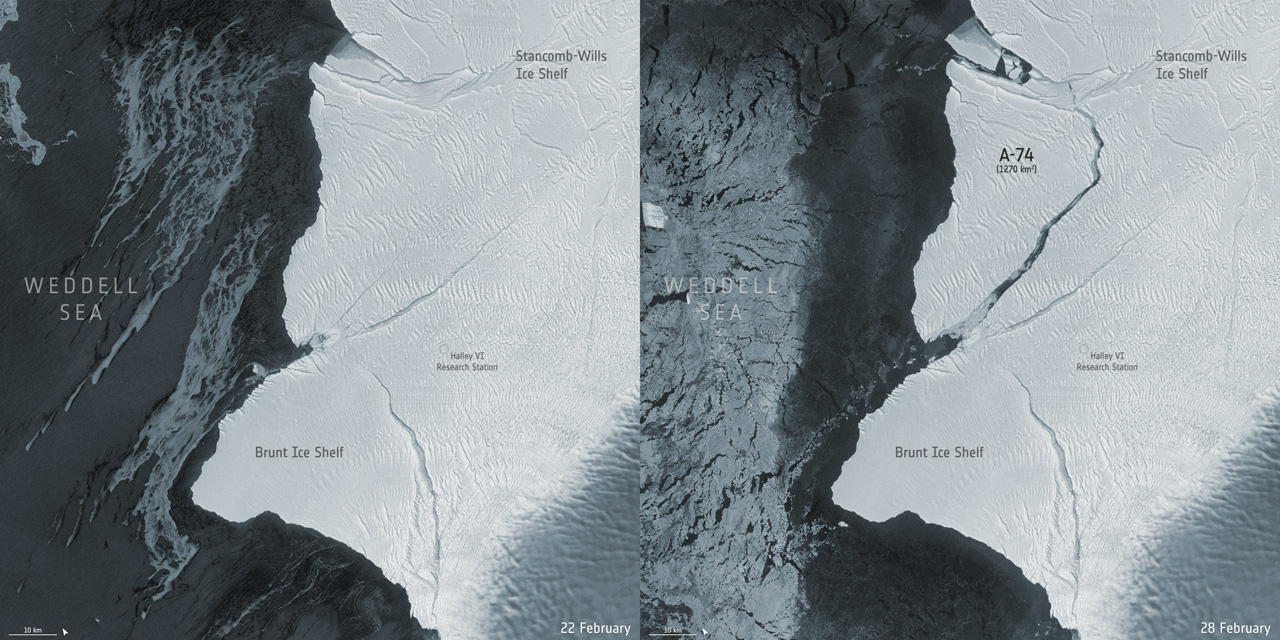
After over five months of lingering around where it had formed, iceberg A-74 was finally captured by the currents flowing around the Weddell Sea and dragged to the south.
For about a week, starting on August 9, A-74 likely had satellite scientists on the edge of their seats. Imagery from the Copernicus Sentinel-1 mission showed A-74 scraping past the southwest tip of the Brunt Ice Shelf, just barely avoiding a full-on collision in the process.
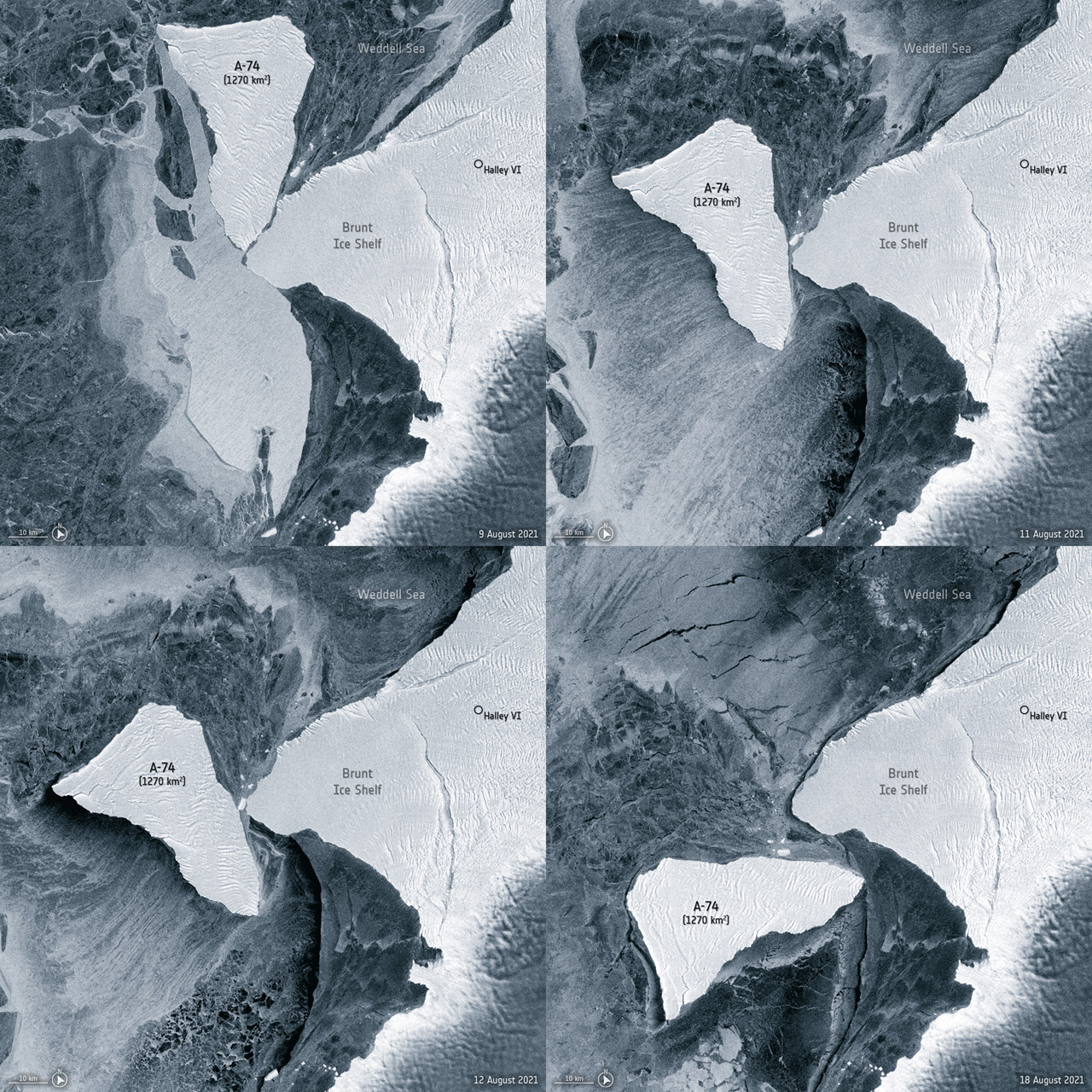
“The nose-shaped piece of the ice shelf, which is even larger than A-74, remains connected to the Brunt Ice Shelf, but barely,” Drinkwater said in an ESA press release on August 20. “If the berg had collided more violently with this piece, it could have accelerated the fracture of the remaining ice bridge, causing it to break away.”
As of August 30, A-74 has remained roughly in the same location it was seen on August 20. It has even shifted a bit closer to the edge of the ice shelf during that time. Further satellite monitoring will reveal if there is any chance of it assisting the Brunt Ice Shelf in producing a new iceberg in the days or weeks ahead.
IS THIS CLIMATE CHANGE?
Ice shelves are extensions of glaciers on land. Gravity pulls the end of the glacier down to the shoreline. The glacier’s immense weight then pushes the leading edge of the ice out so that it floats on the water. Since it remains attached to the ice on land, it forms a shelf. Stresses from the continual glacial push from behind and from ocean currents flowing past the leading edge of the ice shelf cause pieces of the ice to break off (or “calve off”). This produces icebergs, and it is simply a naturally occurring part of the process.
Thus, the calvings of icebergs A-74, and A-76 from May of this year, were likely not caused by climate change. As the British Antarctic Survey said of the calving of A-74, there is “no evidence that climate change has played a significant role.”
However, climate change is having an impact on the health of these ice shelves.
Warmer air temperatures over the land lead to more significant snowfall amounts falling onto the glacier. This increases the weight of the glacier and quickens its press towards the ocean. Meanwhile, warmer ocean water is picking away at the undersides of the ice shelves. This makes the ice more susceptible to fracturing, and it weakens the ice shelf’s connection to the shoreline. Thus, it becomes easier for icebergs to calve off. When an exceptionally large iceberg calves off, it can also lead to a destabilization of the remainder of the ice shelf.
These impacts have already led to the collapse of the Larsen A and Larsen B ice shelves, located near the northern tip of the Antarctic Peninsula. Larsen A, the smallest and most northern of the Larsen ice shelves, disintegrated in 1995. According to the National Snow and Ice Data Center (NSIDC), a 1,700 square-kilometre berg calved off this ice shelf in January of 1995. The rest of the ice shelf then completely collapsed.
At the time, the NSIDC said the collapse of the 2,000 sq km area of ice shelf after the calving “is the more likely of the two events to be related to climate change.”
Three years later, in 1998, the Larsen B ice shelf began to break apart. First, a substantial chunk of the ice shelf’s leading edge broke away that year. Then, between January and March of 2002, more than half of the remaining ice shelf collapsed. This left behind only a tiny remnant in the southernmost part of the inlet.
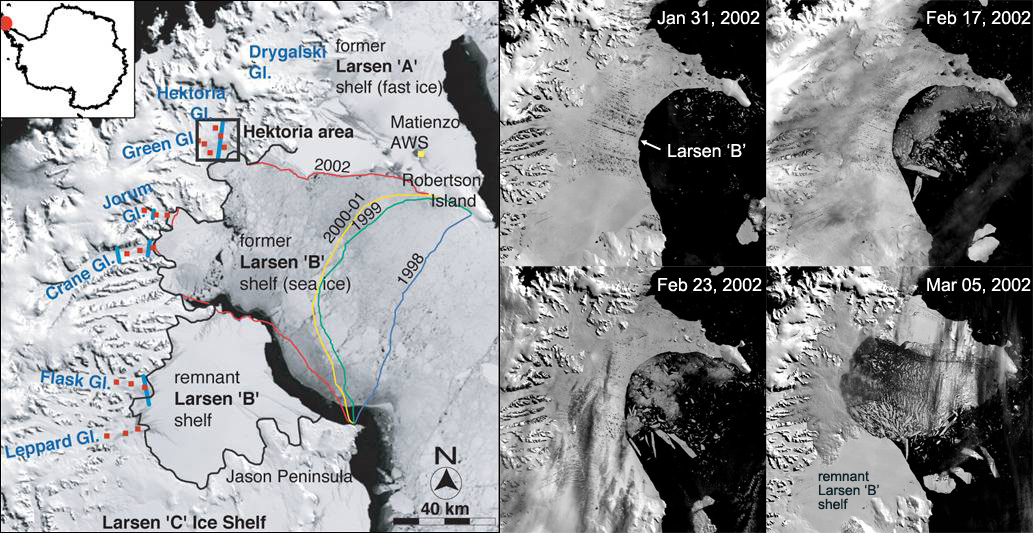
In July of 2017, one of the largest icebergs ever recorded broke off the leading edge of the Larsen C ice shelf. Roughly the same size as the province of Prince Edward Island, iceberg A-68 proceeded to drift out into the Weddell Sea and then into the Southern Ocean.
After a three-and-a-half-year, 2,500 km journey, A-68 finally shattered after it collided with South Georgia Island in late December 2020. NASA says that by April 2021, it had disintegrated and was gone.
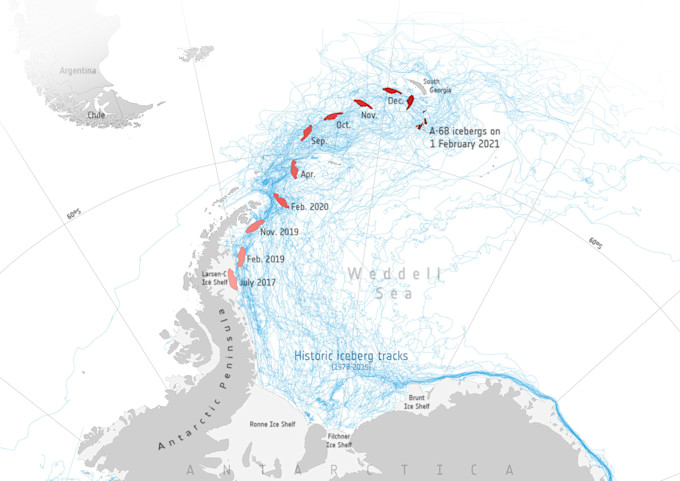
Scientists are still monitoring the Larsen C ice shelf to determine how vulnerable it is following the calving of A-68.
Source: The Weather Network

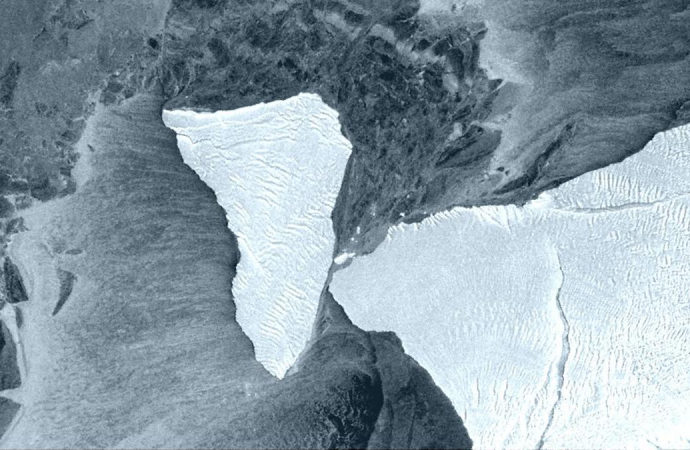































Leave a Comment
You must be logged in to post a comment.